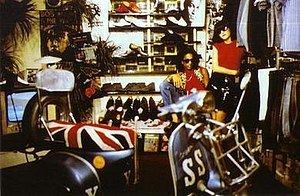Founded 1974 | Headquarters London | |
 | ||
Products Second hand clothing, footwear, bedding, furniture, jewelry, electronics, toys, and housewares. Similar The Roxy, The Photographers' Gallery, Burlington Arcade, 100 Club, Free Trade Hall | ||
Acme attractions 1 anyway
Acme Attractions was a London clothing store on Kings Road, Chelsea, London that in the early 1970s provided a place for many punk and reggae musicians and scensters to hang out. The "Don" of Acme was shop assistant and manager Don Letts:
Contents
Acme was the coolest "club" in town, where the interaction between the different factions became more important than selling merchandise, even though at that age it was a deadly combination.
Acme attractions 2 never again
History
Acme Attractions was inspired by Malcolm McLaren and Vivienne Westwood's Fifties-inspired boutique Let it Rock (revamped in 1972 and renamed Too Fast To Live Too Young To Die). In spring 1974, a radical change saw the shop become SEX: selling fetish wear and Westwood's innovative designs.
Acme's owner, John Krivine, decided to venture into clothing with a man called Steph Raynor. In 1974, Acme Attractions initially opened as a stall on the Kings Road, Chelsea in a place called the Antiquarius. While the store was owned by Krivine and Raynor its public face was Don Letts who says that Acme was selling, "electric-blue zoot suits and jukeboxes, and pumping dub reggae all day long.". The store would actually have to move to the basement, after complaints about Don Lett's pounding dub reggae.
Within two weeks of opening there were queues around the block to get in. Steph Raynor remembers:
We had an office with a (one)-way mirror, and we´d sit in there watching and pissing ourselves because we were so excited at how busy it was, ... I´d get home some nights and I´d have thousand of pounds to count out all over the carpet.
We'd try the clothes on in Acme Attractions, fluffy fake fur jumpers with plastic see-through breast panels, rubber tops and trousers. I wanted plastic dungarees, but they looked horrible. I got Mum to copy the clothes, tight black T-shirts with zips across the nipples. "I should open my own shop. This stuff takes five minutes to make" Mum didn't understand the importance of an original.
By the mid 70s, Acme had quite a scene attracting the likes of The Clash, the Sex Pistols, Chrissie Hynde, Patti Smith, Deborah Harry and Bob Marley. Letts remembers that "Marley ... come by because he knew he could get a good draw from the thriving black-market action that also went on in Acme." The scene created by the shop also led to the formation of Generation X, which launched the pop music career of Billy Idol.
The Acme accountant, Andrew Czezowski, seeing the potential in the crowd the store attracted started up The Roxy, the first punk-rock venue in London, so that people could go from the store and have some place to party. Letts was the first house DJ.
Boy
Seeing the success of punk and how a new market was created for punk related clothing and merchandise John Krevine and Steph Raynor closed Acme Attractions to create Boy. While Don Letts opened the new store, he soon quit, "It was the bastard child of Acme, created to capitalize on the tabloid punk and although I opened and ran the joint it just weren't my speed. I quit to manage the Slits and headed off on the White Riot tour with The Clash."
